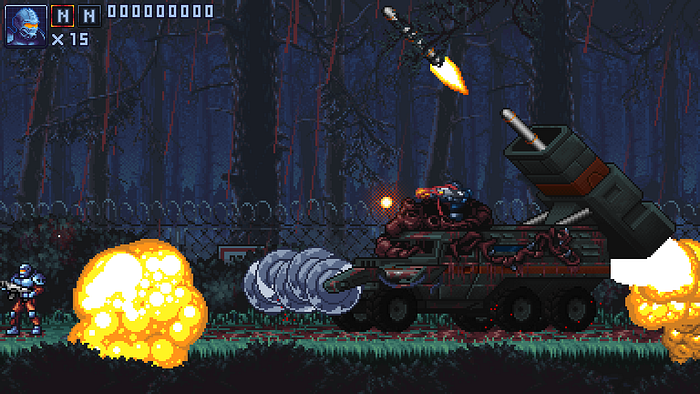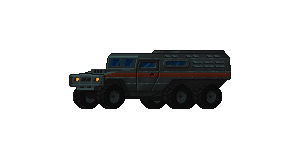Let's Get Toned!
Let's Get Toned!

What Adjectives Can You Use To Describe This Image? || Iron Meat (Forthcoming)
To establish the setting in a video game and, more precisely, the appropriate tone that results from it, is to create a true emotional connection for players. To use a well-known example, I always felt drawn to Final Fantasy VII’s (1997) initial moments of swift urgency, the grimy permanency of a pre-rendered Midgar swallowed by cold steel and seemingly perpetual darkness. In the first playable moments, after Cloud does his flip off the train, we are met not only with the spiky hair protagonist, but with a world void of the natural, an environment entirely constructed, and consumed, by industrial design. After fighting your way through hordes of machines and all sorts of animate and inanimate baddies with lasers, the only reprieve from the brooding slum is at the conclusion of the motorcycle mini-game (and the end of Disc 1). We are finally able to zoom out from Midgar’s manufactured, depressive mood. By this point, the player has a good idea that this game will make them feel quite different from, say, Kirby’s Dream Land 3.
Flipadelphia, I mean Midgar.
We can plot across the medium’s timeline how tone is just as quintessential to game development as character design or controls. Additionally, it contributes to the overall balance of a title. In general, the tone, whether in a video game, book, or movie, is how a piece of art or entertainment makes a participant subjectively feel — the adjectives we use to describe both the title and our reaction to it. However, tone, unlike setting, is not as cut and dry. It is not one specific contribution, but rather is generated through a myriad of elements (setting, mechanics, music, etc.)
In forthcoming Iron Meat, player-character Vadim is met with a brutal onslaught of an alien life form dubbed “the Meat”. During the game’s earliest designs, the tone was lacking, but, perhaps intuitively, became more refined with each updated mechanic. As we continue to work on the title here at Screenwave Media Games, there is now no limit to how bloody, how explosive, how destructive we can make it. In turn, we’ve created a game with some serious psychological horror —a run-and-gun as addictively fun as it is disturbing. “The Meat” consumes and consequently mutates everything and everyone within everyday, real-life settings such as military bases, cityscapes, and moving trains.
Before “Tone” || After “Tone”
The locations at the core of Iron Meat’s levels can be argued as “generic” but in this commonality, developer Razz has set a tone that is actually easier for audiences to resonate with. In fact, the first level progresses in a forest — commonplace for the start of a game, especially one that is retro-inspired. Razz explained to me that it is “a very ordinary military base, where no one expected an attack, especially [from] mutants or aliens. What is happening is a shock [to] the garrison.”
When I think “forest”, visions of isolation or at least an untouched swath of nature comes to mind. By opening the game with a normally unscathed place, but then intertwining unexpected chaos within it, Razz is flipping player expectations and creating tension that drives the player to continue — that even a “peaceful” forest is not safe by the all-encompassing Meat. Players are able to envision these ordinary settings in the normalcy of their own lives, allowing them to be better invested with what is happening on the screen — and more open things a bit more… “meaty”.


Before “Tone” || After “Tone”
Developers should always consider the conflicting and harmonizing elements of their game in relation to the tone they are attempting to create, specifically in terms of mechanics. As YouTube channel Extra Credits exemplifies, “Imagine Silent Hill 2 with Bayonetta 2’s mechanics.” Which combat design you decide to use in your game is just as influential as the narrative, music, or setting to the game’s overall tone, thus a player's enjoyment.
Additionally, it is no secret that players take on a more active role in gaming than if watching a movie. The audience is solely responsible for a character’s controls and getting a sprite from point A to point B, not to mention the obstacles, NPCs, and decisions they may encounter along the way. As such, it is the job of a development team, regardless of how small the team or the game, to always invest in the proper tone so a player initially and continues to feel truly immersed in a title. It’s why Silent Hill 2 continues to be as eerie, as suspenseful as it is today. It is also why I am still able to play the original Final Fantasy VII — even as the sluggish mechanics, boxy graphics, and erroneous localization continue to poorly age.
-Tara
Get Iron Meat
Iron Meat
Classic Run'n'gun game.
| Status | In development |
| Author | Razz |
| Genre | Platformer |
| Tags | 2D, Arcade, Gore, Pixel Art, Retro, Shoot 'Em Up, Side Scroller |
More posts
- THE MEAT HAS BEEN RELEASEDOct 08, 2024
- Demo update: translated into 13 languages!Jun 06, 2024
- Demo updateSep 02, 2023
- Demo updateMay 26, 2023
- Demo updateJun 15, 2022
- Keeping BalanceJul 27, 2021
- Iron Meat: MORE SKIN, MORE SOUNDS, MORE MEAT!Jul 09, 2021
- Demo updateJun 25, 2021

Leave a comment
Log in with itch.io to leave a comment.